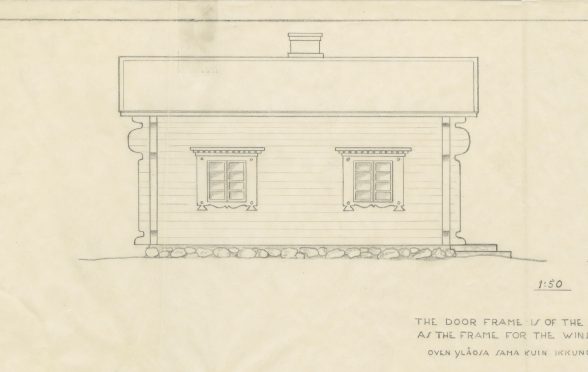This website uses cookies
This website uses cookies to enable it to function properly and to analyse how the website is used. Please click 'Close' to accept and continue using the website.



Image: Wendy Liu / British Sauna Society
C20 is supporting a bid to list a rare survivor from the 1948 London Olympic Games, and has enlisted the help of the Finnish Ambassador. The Finnish Sauna Bath is a prefabricated timber structure originally located in the Athletes Village at the Games, now residing in Aylesford, Kent. It survives remarkably intact, retaining almost all its original internal finishes and fixtures, and is thought to be the oldest functioning sauna in the UK, and the oldest Olympic sauna anywhere in the world.
The Finnish Ambassador to the United Kingdom, Jukka Siukosaari, who visited the building in summer 2023, has called for the building to be restored and opened for public use, adding that ‘its preservation is important not only because of its unique architecture, but also for its history relating to Finnish-British relations and what it means for our common sporting history.’

Image: Historic England
Prefabricated Timber Trade
The timber sauna building was designed by Toivo Jäntti – one of the two architects behind Helsinki’s 1938 Olympic Stadium – and produced by Finnish industrial enterprise Puutalo Oy, a leader in the export of prefabricated wooden structures. The UK was among Puutalo’s most important export destinations in Western Europe during the immediate post-war period. The company received a first order for 30 semi-detached houses in 1946 from the North of Scotland Hydro-Electric Board, which was building large hydropower plants in the Highlands. In 1948, this was followed by a larger order consisting of 47 semi-detached houses and 138 single-family houses. In 1950, the Finnish and British governments signed a trade agreement which led to Puutalo selling large numbers of prefabricated schools to UK. During the first three years, the company delivered more than 100,000 m2 of school buildings to England, Scotland and Northern Ireland.
In 1948, Puutalo and its competitor, the Puurakenne Sales Association, donated a sauna building to be erected in London´s makeshift Olympic Village, located at Richmond Park in a re-purposed Army convalescence camp. After the Games, the Albert Reed Company – at the time, one of the biggest importers of Finnish timber, for paper production- acquired the building and moved it to the vicinity of its facilities in Maidstone.

Image: Wendy Liu / British Sauna Society
Austerity Olympic Games
London 1948 was the first Olympic Games to be held after the Second World War, it coincided with a period of economic hardship and provision for athletes was limited, giving it the name the ‘Austerity Games’. No new sporting venues were constructed and accommodation for male athletes in Richmond Park was built from temporary constructions, while women were housed in existing buildings.
Excluding football grounds, of the venues located in London, only the Empire Pool in Wembley (now Wembley Arena) – designed by Sir E Owen Williams (1934), and used for boxing, diving, swimming and water polo – and Herne Hill Velodrome (1891) survive in any meaningful capacity. A further remnant of the temporary Athletes Village was identified by Simon Inglis in Played in London (2014); one of the army huts still lives on as a rudimentary clubhouse for the Malden Rifle and Pistols Club.
This makes the sauna a rare and important survivor from this nationally important sporting event, and a unique historic example of traditional Finnish sauna culture in the UK.

Image: Wendy Liu / British Sauna Society
Jukka Siukosaari, Ambassador of Finland to the United Kingdom:
“The sauna has been an integral part of the Finnish way of life for centuries. For us Finns the sauna is a spiritual as well as a social institution, which delivers undisputed health benefits as well.
Our top athletes have also recognized the advantages of the sauna. Five-time Paris 1924 Olympic medallist, Paavo Nurmi, said that having a sauna in between races vastly aided his recovery time and allowed him to perform at a maximum level.
The London 1948 Olympics athlete’s village sauna is possibly the oldest surviving Olympic sauna to date. Its preservation is important not only because of its unique architecture, but also for its history relating to Finnish-British relations and what it means for our common sporting history.
Recognising the importance of the building and restoring the sauna for public use would be a story worth telling for generations to come.”

Image: Serlachius Museums archive
Further Sauna Survivor
The Society is also aware of one even earlier former-sauna building in the UK, now converted to a guest house.
Nonington College of Physical Education, operated in a Tudor manor milieu in St. Albans Court in Kent, was opened in July 1938 to educate women as physical education teachers. It has its origins in the English-Scandinavian PE summer schools that had been organised in England since 1923. The founder for the school, Gladys Wright based her ideology of PE teaching on methods of Elli Björksten, a pioneer of Finnish physical education.
In 1938, industrialist Gösta Serlachius organised the donation of a sauna to the college, for the purpose of introducing Finnish culture to Brits and promoting trade relations. Artist Hannes Autere was commssioned to design a building that appeared ‘as Finnish as possible’, with a redwood exterior and decorative window and door frames, that aped the traditional peasant construction style. Opened in 1939, the sauna was in use until the college was sold to Kent County Council in 1951, whereafter it was relocated to a private residence elsewhere in the village of Nonington, and converted for usage as a four roomed guesthouse.
C20 Society would like to thanks the British Sauna Society for their help in researching the history of both of these buildings, and support for the listing application.

Image: Google Maps

Become a C20 member today and help save our modern design heritage.